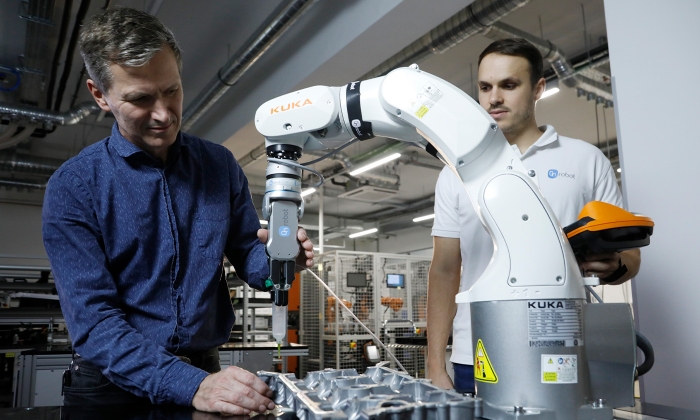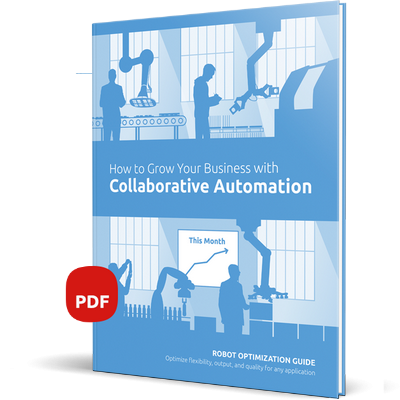How to overcome top 4 challenges to robotic automation


Understand the most significant robotic automation challenges for small and medium-sized manufacturers and learn how to handle them.
Manufacturers worldwide foresee a significant increase in capital spending on industrial automation over the next five years, according to the 2022 McKinsey Global Industrial Robotics Survey.
However, a number of adoption barriers remain, the most notable of which are the cost of the robotic hardware and the company’s general lack of experience with robotic automation, as cited by 71 percent and 61 percent of respondents, respectively.
In this article, we will explore the four primary robotic automation challenges and ways to overcome them as a small and medium-sized manufacturer:
1. High initial investment
The initial cost of robotic automation is the main deterrent for SME manufacturers, and securing funds is an uphill battle as many investors still view robotic automation as a high-risk investment with the return on investment happening a long way down the line due to lengthy implementations.
Add to this the concern that the robotic automation solutions may not be implemented or used to their full potential, and it is no surprise that some SMEs hesitate to invest in robotic automation.
How to overcome the challenge:
Instead of seeing robotic automation as an organization-wide change, view it as a series of distinct projects, as recommended by this study. Start small with a single robotic application, gain experience and a positive business case to use with investors. Then you can scale at need or as funds become available.
The most common robotic applications to start out with are:
- Palletizing
- Packaging
- Pick and place
- Machine tending
- Material handling (ground movement)
- Goods receiving (unloading and storage).
Collaborative robot solutions have made it possible for human workers and robot arms to work side by side, allowing you to ease in robotic automation one workstation at a time.
Once you have deployed your first robotic work cell successfully, you can deploy the next application smoother and faster.
2. Technical issues
One of the main technical issues faced by manufacturers is the fact that there is no international standardization of programming languages or robotics hardware. This makes deployment complex and time-consuming and demands specialist programming skills.
How to overcome the challenge:
While we wait for international bodies to fix the standardization issue, the robotics industry is working on low-code and no-code solutions to automate the programming and integration of robots, tools and machinery. Integration platforms are making life easier for integrators and manufacturers alike, as they help you deploy your robotic applications in record time with a minimum of programming required.
3. Lack of qualified labor force
The lack of qualified workers is cited as one of the main barriers for manufacturers in industrialized countries and developing economies alike.
Deploying and redeploying traditional industrial robotic applications as well as collaborative applications require substantial programming skills, which most small and medium-sized manufacturers cannot find in-house – and sometimes not even externally, as integration specialists are in high demand.
How to overcome the challenge:
If you employ mainly unskilled workers, some upskilling and retraining will be necessary. However, the qualification barrier has been lowered significantly – first with collaborative robots and now with OnRobot’s automated, zero programming integration and deployment platform D:PLOY. This platform essentially eliminates the need for external as well as in-house programming skills and allows you to deploy and redeploy your robotic applications in a few hours.
4. Lack of organizational buy-in
Fear of organizational backlash is making some SME manufacturers hesitate to automate their production line.
Despite the current shortage of labour in the manufacturing industry, workers worry that robotic automation will put them out of a job, but the threat of robots taking over the workforce is greatly exaggerated. In truth, only 14 % of workers say they’ve seen their job replaced by a robot, according to a 2022 study by Eric Dahlin, sociology professor at Brigham Young University.
How to overcome the challenge:
This is a management and a communication issue more than anything else.
Jobs are not cake. While robots do take over repetitive, arduous or dangerous tasks, new, higher-pay jobs are typically created in their wake. The robotic applications need to be redeployed or adjusted, and with collaborative robots, human workers can work alongside the robots, producing more in a safer, more rewarding environment. You probably know that. But your workers might not.
So communicate your plans for the automation process, including the plans for training to upskill workers and the tasks they will be undertaking after the automation.
And involve your workers in the process. They have hands-on experience with the processes you wish to automate. Use their knowledge to plan the automation. Find out which aspects of the job are most undesirable, and start by automating those.
D:PLOY - The next big leap in automation
We’ve made robotic automation simpler with D:PLOY. D:PLOY is the industry’s first automated platform for building, running, monitoring, and re-deploying collaborative applications.
It automates the process of getting a robotic application up and running, allowing deployment directly on the manufacturing floor with zero programming and zero simulations. With D:PLOY, complete applications can be deployed in just a few hours.
Learn more about industry's first automated platform for deployment of collaborative applications.
Sources:
1. Ajewole, Femi, Ani Kelkar, Dylan Moore, Emily Shao, and Manju Thirtha: Unlocking the industrial potential of robotics and automation. McKinsey & Company, 6 January 2023. https://www.mckinsey.com/industries/industrials-and-electronics/our-insights/unlocking-the-industrial-potential-of-robotics-and-automation#/
2. Sayem, A.: Biswas, P.K.; Khan, M.M.A.; Romoli, L.; Dalle Mura, M. Critical Barriers to Industry 4.0 Adoption in Manufacturing Organizations and Their Mitigation Strategies. J. Journal of Manufacturing and Material Processing, 2022, 6, 136. https://www.mdpi.com/2504-4494/6/6/136/pdf
3. Dahlin, E.: Are Robots Really Stealing Our Jobs? Perception versus Experience. Socius, 8, 2022. https://journals.sagepub.com/doi/10.1177/23780231221131377

|
Cómo hacer crecer tu negocio con aplicaciones colaborativas
Con la llegada de herramientas adaptadas más inteligentes y adaptables, los robots ahora pueden funcionar con mayor velocidad, fuerza, seguridad y precisión, realizando una amplia gama de tareas y maximizando el ROI. Aprende más sobre cómo puedes conseguir una producción más rápida a más bajo coste descargando nuestro libro electrónico gratuito.
DESCARGAR EBOOK GRATUITO
|

|

